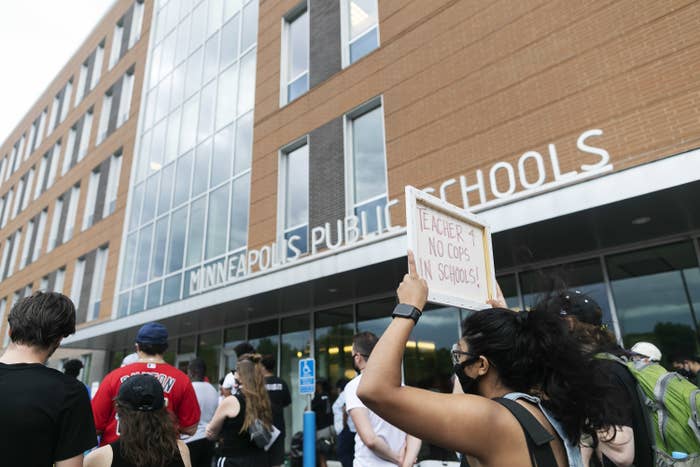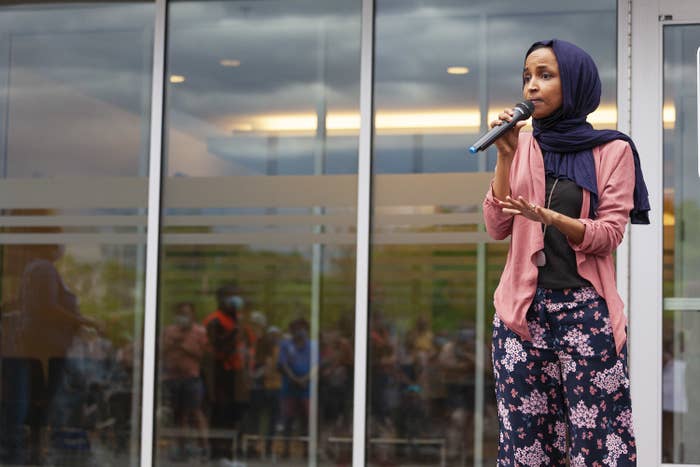
The board of Minneapolis Public Schools voted unanimously Tuesday to end the district’s $1.1 million contract with the Minneapolis Police Department after the death of George Floyd, saying the actions of city police officers “run directly counter to the values” of the school district.
It is among the earliest and most tangible victories so far for activists protesting Floyd’s killing, who have demanded that police departments be reformed, defunded, or abolished in order to stem police violence. Few, if any, school districts have ever taken such a dramatic step over the issue.
Several hundred people, including Rep. Ilhan Omar, gathered outside the district building before the vote.
Students at local high schools and community groups had been organizing for years to try to force the district to remove police, called school resource officers, from city schools. But after three high-profile police deaths in the city and an incident with a racist Christmas tree, there was little concrete action from officials beyond incremental steps to reduce the number of officers and train police.
Then George Floyd was killed on the street in south Minneapolis.
Floyd’s death was different in part because the conversation seemed to have simply changed, said Nathaniel Genene, a student activist and a junior at a public high school in south Minneapolis.
“We could have had the debate all day: Do you put your money into police or social services and counselor support?” Genene said. “That’s a back-and-forth that was going on for a long time.”
Floyd’s killing and the outrage that followed, Genene said, “just ended that conversation. It was: ‘Do we align with the Minneapolis police, do they align with our values? Can you continue to align yourselves with a group of people that disenfranchise your students?’ I don’t think it was the same conversation anymore, morally.”
Two days after Floyd's death began to roil the city with protests and riots, the University of Minnesota said they would cut some ties with the Minneapolis Police Department. Shortly after, Minneapolis Public School board members introduced a resolution to end the school district’s own contract with police entirely. One called immediately for a special meeting. An onslaught of emails poured in from students and community members, one board member said.
“This vote is about justice,” said Siad Ali, the board’s director, during the meeting Tuesday. “It’s about time we end this contract with the Minneapolis police. They do not meet our values, and therefore, we will have no business with this organization.”
In the wake of increased national scrutiny over the efficacy and safety of school resource officers contracted from local police departments, some districts have tried reform measures, including trying to limit officers’ involvement in any school discipline.
But there’s little precedent for a school district ending its contract with police entirely as Minneapolis has, said Marc Schindler, the executive director of the Justice Policy Institute, an advocacy organization.
“I’m not aware of school districts actually making those decisions,” Schindler said.
As anger over race and policing sparked by what happened in Minneapolis reaches a fever pitch nationwide, Minneapolis Public Schools’ termination of the contract could fuel similar pushes in other school districts, Schindler said, along with economic pressures from the coronavirus that will lead districts to rethink how they spend their limited money. A school board member in Denver, Tay Anderson, called last week for the city’s district to cut its ties with police.
“Hey New York, hey Colorado, hey Nevada, look at us — we’re making a change with our voices, just like our parents and neighbors are, and you can do it too. Students can do the same thing and pressure our elected officials,” said Janaan Ahmed, a student activist who graduated from Minneapolis’s Patrick Henry High School this week.
“If it wasn’t for the riots that happened on 38th and Lake, if it wasn’t for Minneapolis residents getting out in the streets, the nation wouldn’t look like what it is right now.”
The push, which Ahmed said she had learned about her first year of high school four years ago, had grown in city schools in recent years after a spate of killings and other incidents by police officers in and around Minneapolis.
There was Jamar Clark, in 2015. There was Philando Castile a year later, an employee of St. Paul Public Schools, just across the river. Two years later, there was the racist Christmas tree, which Minneapolis police officers decorated with Popeye’s chicken, malt liquor, and crime scene tape. Then the Minneapolis police union’s president wore a shirt that read “Cops for Trump.”
Minneapolis public school students have been among the tens of thousands of protesters flooding the city since Floyd’s death. Some have been caught up in police crackdowns involving tear gas and rubber bullets.
Ahmed said she had seen a former classmate on a livestream who had been hit in the head by a rubber bullet. He had been one of the first voices she’d heard advocating to get police out of her school, she said, back when she was a first-year student.
“That was one of my peers — we walked the halls together."
Ahmed thought images like those had forced school board members to confront the reality of police’s relationship with students: “We see police officers tear-gassing and shooting rubber bullets at youth that go to Minneapolis public schools, so how can you sit with yourselves as a school board, as elected officials, with students getting shot?”
Some 1,600 Minneapolis students responded to a survey sent out by Genene and other student activists, he said in the board meeting Tuesday. More than 90% voted for “total divestment” from the police department.

Before the vote Tuesday, said one community organizer, adults had for decades dismissed students’ insistence that school resource officers, meant to enforce safety measures, had in reality made them feel less safe.
“To see George Floyd on the pavement, already restrained, that was something that was undeniable,” said Kenneth Eban, an organizer with the group Our Turn. “But in a way, that was sad and unfortunate, because students have been saying this for years. It feels unconscionable, that you couldn’t just listen to the people who were most deeply impacted by what’s happening.”
Some officers in Minneapolis schools have close relationships with students. At North High School, which is predominantly black, the school’s resource officer, or SRO, is also the football coach.
A group of 10 North students spoke before the vote Tuesday about the officer as a “father” who made them feel safer, according to a reporter for the Star Tribune. “With SROs gone, nobody’s going to feel safe at school,” one student said.
Eban said the school officer at North was a “superstar.”
“What’s important to remember, though, is that this is a system, and the system cannot be built off of one superstar,” Eban said. “We need to figure out and identify a new vision of safety for Minneapolis and Minneapolis schools. We can do that. We just need to accept the idea that officers don’t need to be part of the solution.”
Across town, at South High School— just blocks from the Third Precinct, near where Floyd was killed, which was burned to the ground by protesters last week — there had been tensions with law enforcement for years, students said.
“Students really don’t feel safe because we don’t have established relationships with our SROs,” said Zigi Kaiser, a South student. “We aren’t able to trust them in any situation.”
Student activists wanted to be clear on what the vote from the school board meant. Ahmed said she plans to continue a fight to convince the board to change the name of her high school, named for Patrick Henry, who enslaved black people on his plantaiton.
And the fact that the board’s sole student representative was not allowed to vote on its resolutions?
“That’s a conversation we’re going to have too,” said Genene.
“It’s just a message to Minneapolis Public Schools: Hey, we’re not done, we’re just starting,” Ahmed said. “You guys can vote and do this in two hours, imagine what you can do in the next ten hours. We’re not stopping.”
